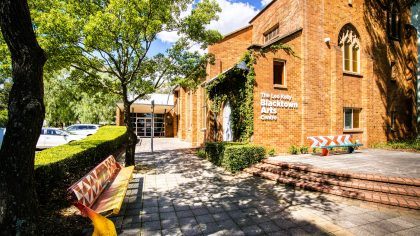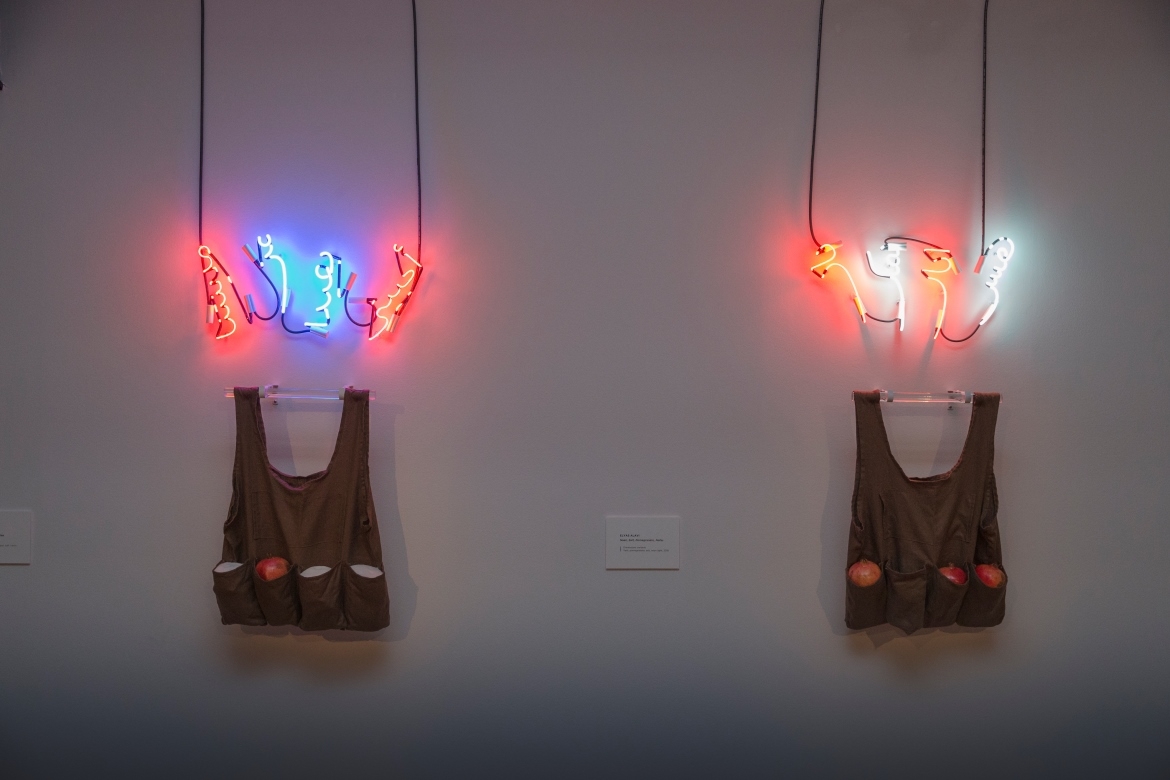
The Leo Kelly Blacktown Arts Centre
An innovative multi-arts hub in the heart of Blacktown City.
Bayadyinyang budyari Dharug yiyura Dharug Ngurra.
Bayady’u budyari Dharug Warunggadgu baranyiin barribugu.
Bayady’u budyari wagulgu yiyuragu Ngurra bimalgu Blacktown City. Flannel flowers dyurali bulbuwul.
Yanmannyang mudayi Dharug Ngurrawa. Walama ngyini budbud dali Dharug Ngurra Dharug yiyura baranyiin barribugu.
We acknowledge the Traditional Custodians of this Land, the Dharug people, and their continued connection to Country.
We pay our respects to Elders from yesterday to tomorrow.
We extend that respect to all Aboriginal and Torres Strait Islander Peoples of Blacktown City where the flannel flowers still grow proud and strong.
We will walk softly on this land and open our hearts to Country as the Dharug people have for tens of thousands of years.
Credit to: Dharug woman Rhiannon Wright, daughter of Leanne ‘Mulgo’ Watson Redpath and granddaughter of Aunty Edna Watson

Abdul Hekmat is a photographer and freelance journalist who has written for The Australian, Sydney Morning Herald, The Age, the Guardian, The Saturday Paper and The Monthly. He is finalist for the Freelance Journalist of the Year Walkley Award 2018, and has been a finalist twice for the United Nations Media Peace Prize. He is also a PhD candidate at the University of Technology, Sydney, where he explores refugee lived experiences through art and narrative writings.
We invited Abdul to respond to our artistic program, Daneha (Seeds).
In a half-darkened space, two suicide-like vests hang on the gallery wall at The Leo Kelly Blacktown Arts Centre in Western Sydney. A few grenade-like objects protrude from the pockets. Salt from another pocket has poured out and is spread on the floor. Above the vest, Arabic words are lit up in neon. It resembles the suicide vests worn by terrorists that have ripped through crowds in Kabul or the Middle East. Here, Elyas Alavi, mixes poetry and materiality to invoke the idea of peace, hope and life, through his work Naan, Salt, Pomegranate, Nafas (2018) — nafas, meaning ‘breath’. However, the objects in the suicide vest are pomegranates, and the Arabic words are a poem by the Syrian poet, Nizar Qabbani. The text reads ‘love me beyond my city’, and was inscribed on the ruined walls of buildings in Damascus, to offer some hope in a city devoid of hope. “Through this work, I dream of a time when the pockets of these vests are filled with simple words such as naan (bread), pomegranates or home rather than guns, bullets or grenades,” the artist explains.
Alavi, an Afghan refugee based in Adelaide, is also a poet and was inspired to create this work in response to the ongoing suicide attacks in Afghanistan where his family still lives. He survived a bomb blast in August 2016 that killed over 92 Hazara peaceful protesters, injured over 300 and shattered the shop windows around him. Alavi is one of five artists featured in Daneha (Seeds) and collaborative projects with the Afghan community, an initiative of Blacktown Arts to tell the displacement narrative of Afghan refugees settled in Blacktown and globally, one that is not defined by horror but by a positive affirmation of their own agency, identity and experience. Their artworks are ‘underpinned by cultural and linguistic links to Persia. It connects with local, national and global issue of displacement, loss, survival, resilience and challenges of resettlement,’ the label on the gallery wall reads.
Paul Howard, visual arts curator and Maria Mitar, performance curator at Blacktown Arts have brought together the works of refugee artists as well as the stories of Afghan women (from the group Afghan Women on the Move) to connect refugee artists based locally, nationally and internationally, bringing different artistic styles as well representing works that are profoundly personal, latent with memories of loss and trauma. Whilst the exhibition showcases such personal responses to the condition of displacement, the work also becomes a weapon for challenging the narratives that underpin Australian and the rest of the world’s conceptions of refugees, who are seen as helpless victims, who are always in need of rescue.
In a period where images of horror regarding refugees and asylum seekers fill our TV screens and talkback radio, Daneha transcends the current political moment. Rather than be defined by horror stories of displacement and trauma, Daneha seeks to show how refugees find their own narrative and empowerment through art. The exhibition is unique in many ways, most importantly for being driven and formed in consultation with artists and refugees. The program notes state, ‘From this seed, the creative team seeks the formation of new cultural identities, led by artists and community groups from the Persian cultural region, including Afghanistan, Kurdistan and Iran.’
For over two months, Blacktown Arts – the two gallery spaces and the performance studio – have been transformed into a community art space, showcasing installation works, painting, and theatre works by Monirah Hashimi, an Afghan writer and artist who is based in Sweden. The gallery space is filled with homely artefacts, Afghan rugs, a tea table that welcome the visitors with Afghan chai, sweets and dried berries.
Another work by Elyas Alavi, the Uprooted Trees, speaks of his strong bond to his hometown, Daikundi, a mountainous place in central Afghanistan which he left as a child. A traditional notion of home is to be rooted to a place. Because the artist cannot physically return he instead makes a poetic return to his home, which invokes Rumi’s poem “anyone who has remained far from his roots, seeks a return to the time of his union.” Elyas’ strong connection to his place was formed whilst he lived as a refugee in Iran, where he was stigmatized for being an Afghan refugee, causing a loss of identity, of feeling neither here nor there. Sketches on white paper appear to fade. Ghostly images can be discerned with a closer look; a reminder that such images are slowly disappearing from his memory.
The Daneha exhibition shows the inner lives of the artists – a type of shared consciousness – a condition of multiple and new identities through art. This is presented through the new work of Khadim Ali, Golden Country (2018), in which dozens of Australian native animals, such as the koala, kangaroo and crocodile, are displayed on a dark wall. A large installation made of steel cut images, it dominates the gallery space, radiating under a florescent light. The process behind the creation of this work was intensive; Khadim used Persian and Arabic calligraphic letters to cut and polish the steel.
Ali was inspired by the 17th and 18th Century Afghan and Persian tradition of depicting nature, which came into practice after the fatwa banning images of bodies that contain souls. Ali uses native Australian animals in the form of words of praise to depict the transition of refugees’ perceptions, showing how they adapt their traditional understanding to give rise to new meanings in multicultural Australia. The work enables him to maintain a connection with Australia, the country he has called home over the past ten years. Although Khadim is a miniature painter in the Mughal tradition, in recent years he has produced artwork that employs Australian imagery, including Australian soldiers and animals, to make a point about his new identity and home.
Home and identity for Khadim have always been fraught with trauma, otherness and displacements. Having left Afghanistan to find refuge, Khadim lost his family home in a bomb blast in Quetta, Pakistan, in 2012. His mother and brother were buried under the rubble and were fortunate to survive. His mother arrived in Australia six years ago and had just received her Australian citizenship only to be diagnosed with a terminal illness. She passed away recently, adding another layer of trauma to an already fractured life. (His mother, Amina, last appeared at Khadim’s exhibition at the opening of Daneha).
In a collaborative work by Khadim and Kabul-based artist, Sher Ali, we view a sleeping Buddah carried by three horned demons; characters that Khadim has drawn from the heroes of Shahnama (the traditional Persian ‘Book of Kings’). The roaring lions feature Sher Ali’s work. The iconography of this work evokes cultural displacement and a lost heritage, in recalling the Buddah statues of Bamiyan, which were dynamited by the Taliban in 2001.
Kurdish artist, Avan Anwar, captures her traumatic past in an artwork, Indurability of Life (2018), by spreading fresh jonquil flowers on a white wall. The fragile flowers are an emblem of the hidden trauma she carries within her, composed to makes something beautiful; smoothing which can be appreciated. The flower symbolises rebirth in a new home country, after she lost everything; represented in the cyclical process of growth and regeneration that accompanies the planting of seeds. Each flower represents an element of her experience, which balances the past and present.
Another work by Avan, Bing me again (2018), utilises nylon fabric and light bulbs which are hung from the ceiling. The work draws on her personal experience of identity crisis, physical disability and displacement. (She lost the 14 members of her family and her hearing during Saddam Hussein’s chemical attack on Halabja in Iraq when she was five years old). By transforming physical materials, she expresses how cultural change and displacement can lead to new identities. “I want to reinvent what is lost and ‘left behind’, to re-live the past, and as a remedy against forgetting,” she says.
While Daneha presents the experiences of refugees in Australia in a positive light, a video by Atefeh Kasimi and Zahra Kasimi presents a different picture. Speaking in Farsi, these young Afghan refugees grew up in Iran, where they grappled with marginalisation. They had no country to call home and yet didn’t know any other world than Iran. They were targeted with regular insults and treated as outsiders on the streets and at school. Iran is home to one of the world’s largest and most-protracted refugee crisis. More than 3 million Afghan refugees live in Iran and are subjected to discrimination and abuse. They are legally forbidden from owning property, a house or a car.
Of course, displacement cannot be considered without the socio-political and economic context underpinning it. Outside the building you hear the voice recordings of artist, Zainab Haidariy, from a megaphone, reading the official report of ASEAN countries which includes Indonesia, Malaysia, The Philippines, Singapore and Thailand alongside 40 white flags inscribed with numbers mounted on the roof of the gallery that flap in the wind. The work is Speculator (2018), by Zainab Haidariy, an Afghan female refugee based in Germany. It references the economic management of the Association of Southeast Asian Nations (ASEAN) from 1970 -1976. Her creative investigation questions the bigger picture of how decisions made by ‘speculators’ and policy-makers 42 years ago affect our everyday lives. “Can we read conflict from other perspectives by looking back to political and economic decisions made in another era?” Haidariy asks.
While the figure of the refugee is commonly made synonymous with trauma, loss and victimhood, the Daneha exhibition underscores the courage, resilience and agency of refugees who have transformed their trauma and loss into artworks of beauty to be appreciated. Out of loss and trauma something potent emerges which is enriching and beautiful and may contribute to the artistic culture of Australia.
“Modern Western culture is in large part the work of exiles, émigrés, refugees,” Edward Said, a Palestinian cultural critic, wrote in 1984. The exhibition is a poignant example of how displacement can be a site for regeneration and a catalyst for creativity.
Daneha (Seeds)
5 July – 9 September 2018